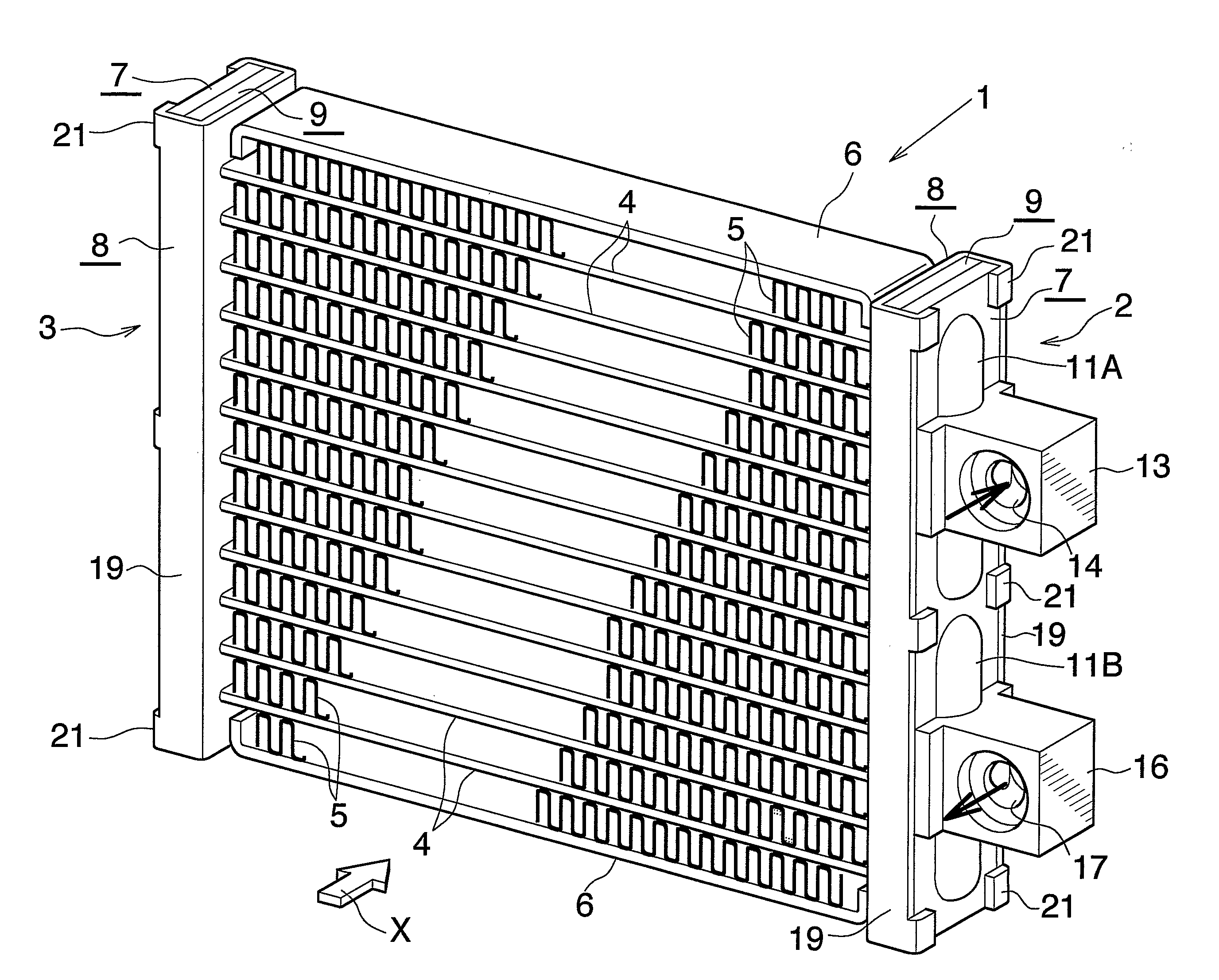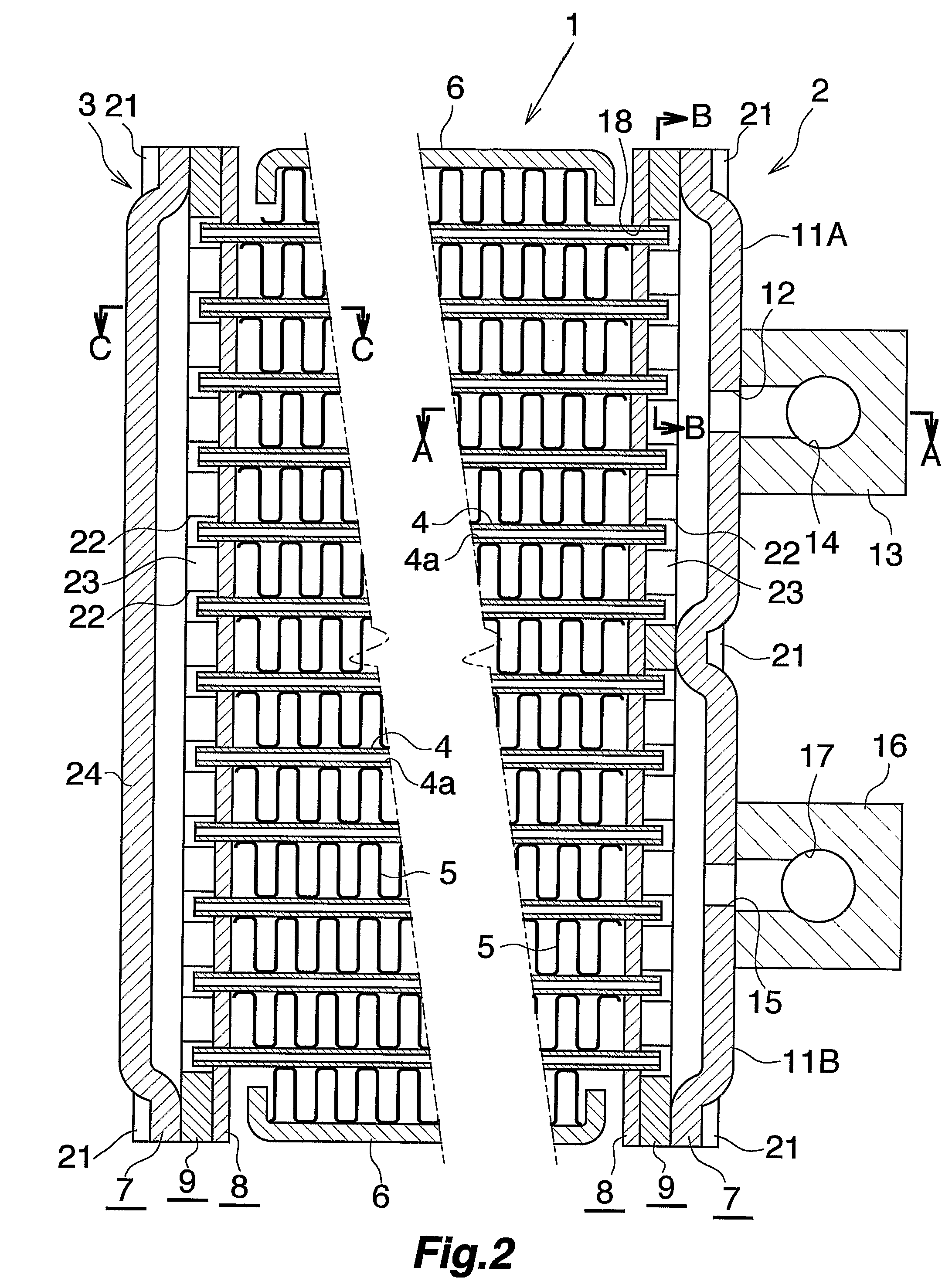Heat exchanger header tank and heat exchanger comprising same
a heat exchanger and header technology, applied in indirect heat exchangers, refrigeration components, lighting and heating apparatus, etc., can solve the problems of cumbersome procedure for partitioning, low efficiency of work for joining the caps, and increasing the number of components, so as to reduce the number of working steps, shorten the working time, and improve heat exchange efficiency
- Summary
- Abstract
- Description
- Claims
- Application Information
AI Technical Summary
Benefits of technology
Problems solved by technology
Method used
Image
Examples
embodiment 1
[0077]This embodiment is shown in FIGS. 1 to 9 and is a gas cooler for supercritical refrigeration cycles which comprises a heat exchanger of the present invention.
[0078]With reference to FIG. 1, the gas cooler 1 for use in supercritical refrigeration cycles wherein a supercritical refrigerant, such as CO2, is used comprises two header tanks 2, 3 extending upward or downward and arranged as spaced part in the left-right direction, a plurality of flat heat exchange tubes 4 arranged one above another at a spacing in parallel between the two header tanks 2, 3, corrugated fins 5 arranged in respective air passing clearances between respective adjacent pairs of heat exchange tubes 4 and outside the heat exchange tubes 4 at the upper and lower ends of the cooler and each brazed to the adjacent pair of heat exchange tubes 4 or to the end tube 4, and side plates 6 of bare aluminum material arranged externally of and brazed to the respective fins 5 at the upper and lower ends. In the case of...
embodiment 2
[0093]This embodiment is shown in FIGS. 10 to 20 and comprises a heat exchanger of the invention adapted for use as an evaporator in supercritical refrigeration cycles.
[0094]With reference to FIGS. 10 to 12, the evaporator 30 for use in supercritical refrigeration cycles wherein a supercritical refrigerant, such as CO2, is used comprises two header tanks 31, 32 extending in the left-right direction and arranged as spaced part in the upward or downward direction, a plurality of flat heat exchange tubes 33 arranged in parallel in the left-right direction at a spacing between the two header tanks 31, 32, corrugated fins 34 arranged in respective air passing clearances between respective adjacent pairs of heat exchange tubes 33 and outside the heat exchange tubes 33 at the left and right ends of the evaporator and each brazed to the adjacent pair of heat exchange tubes 33 or to the end tube 33, and side plates 35 of aluminum arranged externally of and brazed to the respective fins 34 at...
PUM
| Property | Measurement | Unit |
|---|---|---|
| height | aaaaa | aaaaa |
| thickness | aaaaa | aaaaa |
| height | aaaaa | aaaaa |
Abstract
Description
Claims
Application Information
 Login to View More
Login to View More - R&D
- Intellectual Property
- Life Sciences
- Materials
- Tech Scout
- Unparalleled Data Quality
- Higher Quality Content
- 60% Fewer Hallucinations
Browse by: Latest US Patents, China's latest patents, Technical Efficacy Thesaurus, Application Domain, Technology Topic, Popular Technical Reports.
© 2025 PatSnap. All rights reserved.Legal|Privacy policy|Modern Slavery Act Transparency Statement|Sitemap|About US| Contact US: help@patsnap.com



